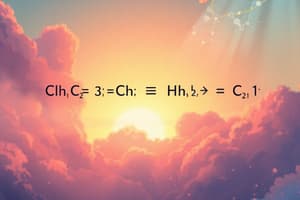Podcast
Questions and Answers
In the reaction of Iron with Sulphur, what is the product formed?
In the reaction of Iron with Sulphur, what is the product formed?
Iron Sulphide
What does the law of conservation of mass state?
What does the law of conservation of mass state?
Mass can neither be created nor destroyed in a chemical reaction.
In the equation Fe + H2O → Fe3O4 + H2, how many iron atoms are needed to balance the equation?
In the equation Fe + H2O → Fe3O4 + H2, how many iron atoms are needed to balance the equation?
3
What is the skeletal chemical equation for the reaction between Magnesium and Oxygen?
What is the skeletal chemical equation for the reaction between Magnesium and Oxygen?
How do you balance the oxygen atoms in the equation Fe + H2O → Fe3O4 + H2?
How do you balance the oxygen atoms in the equation Fe + H2O → Fe3O4 + H2?
What is the chemical equation for the formation of calcium hydroxide from calcium oxide and water?
What is the chemical equation for the formation of calcium hydroxide from calcium oxide and water?
What are the products formed when calcium carbonate undergoes thermal decomposition?
What are the products formed when calcium carbonate undergoes thermal decomposition?
In a displacement reaction, which element displaces copper from copper sulfate solution?
In a displacement reaction, which element displaces copper from copper sulfate solution?
What type of reaction occurs when barium chloride solution is mixed with sodium sulfate solution?
What type of reaction occurs when barium chloride solution is mixed with sodium sulfate solution?
What is the white precipitate formed when barium chloride reacts with sodium sulfate?
What is the white precipitate formed when barium chloride reacts with sodium sulfate?
Flashcards are hidden until you start studying
Study Notes
Writing Chemical Equations
- Chemical equations can be concise and suggestive by using symbols for reactants and products.
- A word equation represents a chemical reaction, e.g., Iron + Sulfur → Iron Sulphide and Mg + O2 → MgO.
Balanced Chemical Equations
- The law of conservation of mass states that mass cannot be created nor destroyed in a chemical reaction.
- The total mass of reactants must be equal to the total mass of products formed after the reaction.
Balancing Chemical Equations
-
A chemical equation must be balanced to obey the law of conservation of mass.
-
To balance an equation, follow these steps:
Step 1
- Draw boxes around each formula and write down the number of atoms of each element present.
Step II
- List the number of atoms of different elements present in the equation.
Step III
- Start balancing with a compound that contains the maximum number of atoms.
- Balance elements one by one, e.g., iron, oxygen, hydrogen, etc.
Step IV
- Examine the equation and pick up the next element that is not balanced.
- Multiply formulas by coefficients to equalize the number of atoms on both sides of the equation, e.g., 3Fe + 4H2O → Fe3O4 + 2H2.
Types of Chemical Reactions
- Calcium hydroxide reacts slowly with carbon dioxide in air to form a thin layer of calcium carbonate on walls.
- Calcium carbonate is also responsible for white deposits in kettles and boilers.
Combination Reaction
- Calcium oxide reacts with water to produce calcium hydroxide: CaO + H₂O → Ca(OH)₂
- Magnesium wire combines with oxygen to form magnesium oxide: 2Mg + O₂ → 2MgO
- In combination reactions, two or more reactants combine to form a single product.
Decomposition Reaction
- Thermal decomposition of copper sulfate crystals results in anhydrous copper sulfate and water vapors: CuSO₄.5H₂O (s) → CuSO₄ (s) + 5H₂O (g)
- Thermal decomposition of calcium carbonate results in calcium oxide and carbon dioxide: CaCO₃ (s) → CaO (s) + CO₂ (g)
- In decomposition reactions, one reactant breaks down into two or more products.
Displacement Reaction
- Iron displaces copper from copper sulfate solution: Fe (s) + CuSO₄ (aq) → FeSO₄ (aq) + Cu (s)
- Zinc displaces copper from copper sulfate solution: Zn (s) + CuSO₄ (aq) → ZnSO₄ (aq) + Cu (s)
- In displacement reactions, a more reactive element displaces a less reactive element from a compound.
Double Displacement Reaction
- Mixing barium chloride solution and sodium sulphate solution forms a white precipitate of barium sulphate: BaCl₂ (aq) + Na₂SO₄ (aq) → BaSO₄ (s) + 2NaCl (aq)
- Such reactions are called precipitation reactions, where there is an exchange of ions between two reactants to form at least one new insoluble compound.
Oxidation and Reduction
- No specific examples or reactions mentioned in this section.
Studying That Suits You
Use AI to generate personalized quizzes and flashcards to suit your learning preferences.




